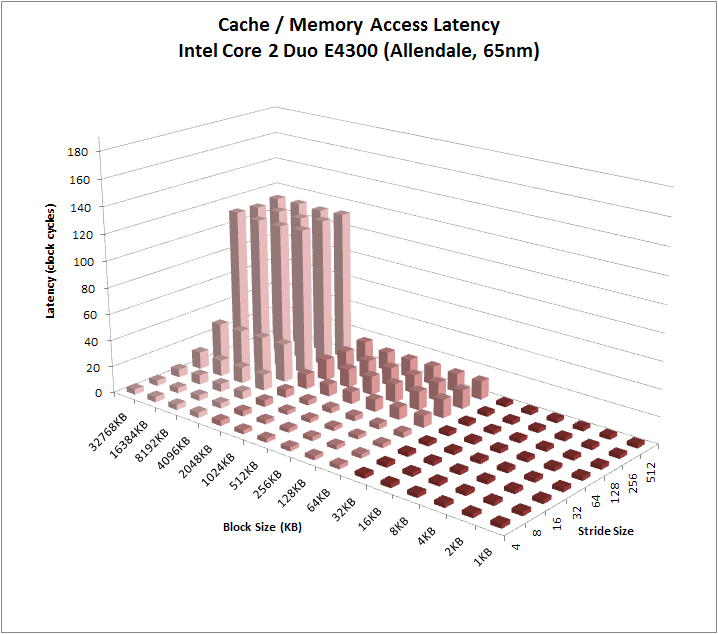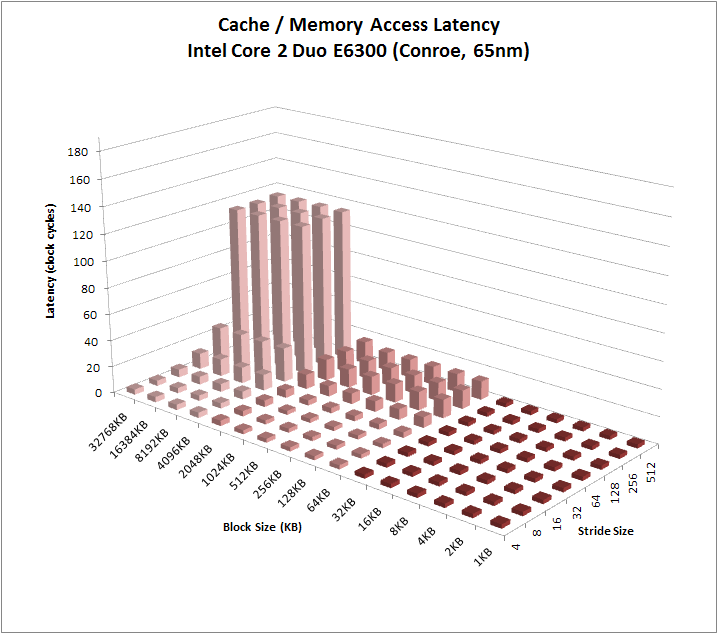If you're not interested in cache latencies, it's probably recommended that you skip on to our real-world performance results.
We used a programme called Cachemem 2.65 to record our results, and because of the differing clock speeds, we have displayed the E4300, E6300 and E6600's latencies in clock cycles rather than converting to nanoseconds. However, because memory clock speed and latencies are kept constant across the three processors (DDR2-800 3-3-3-9), we have attached an animated version of these graphs in nanoseconds to illustrate the (relatively) constant memory latency.
Memory latency (in clock cycles) increases with clock speed, but actual memory latency (in nanoseconds) doesn't change a great deal as clock speed increases. We've also created an animated version of the graphs above with latency measured in nanoseconds to highlight the memory performance across the three different CPUs.

Core 2 Duo E4300 - 1.8GHz, 2MB L2 cache

Core 2 Duo E6300 - 1.86GHz, 2MB L2 cache

Core 2 Duo E6600 - 2.40GHz, 4MB L2 cache
Allendale's Cache:
Before we get onto how the E4300 performs in real-world applications, we decided to explore Allendale's cache latencies, as they can often be more important than memory bandwidth when it comes to accessing large amounts of data in quick succession.We used a programme called Cachemem 2.65 to record our results, and because of the differing clock speeds, we have displayed the E4300, E6300 and E6600's latencies in clock cycles rather than converting to nanoseconds. However, because memory clock speed and latencies are kept constant across the three processors (DDR2-800 3-3-3-9), we have attached an animated version of these graphs in nanoseconds to illustrate the (relatively) constant memory latency.
Things to note:
Roughly speaking, the dark red portion represents the L1 cache latencies, the mid-red represents L2 cache latency and the light red represents main memory. If you want to see the three graphs combined and animated to show the differences in more relative terms, you can see that here.Memory latency (in clock cycles) increases with clock speed, but actual memory latency (in nanoseconds) doesn't change a great deal as clock speed increases. We've also created an animated version of the graphs above with latency measured in nanoseconds to highlight the memory performance across the three different CPUs.

Core 2 Duo E4300 - 1.8GHz, 2MB L2 cache

Core 2 Duo E6300 - 1.86GHz, 2MB L2 cache

Core 2 Duo E6600 - 2.40GHz, 4MB L2 cache

MSI MPG Velox 100R Chassis Review
October 14 2021 | 15:04









Want to comment? Please log in.